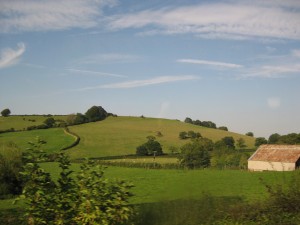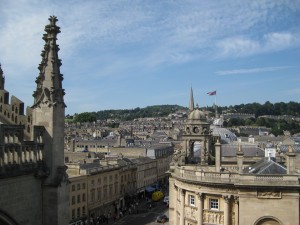I think that some of my favorite activities we’ve done since we’ve been here have been our day trips to Bath, Oxford, and Stratford. I don’t think I could ever live in a city permanently; the crowds, the chaos, the push and shove hustle and bustle in London would definitely be too stressful for me to handle on a long term basis. Driving through the countryside on our way to our destinations was a refreshing break for me, and was much more reminiscent of home than our lives in the city. Below is a picture I took through the bus window on our way home from Bath.
There are several key differences I have observed between London and the smaller cities of Bath, Oxford, and Stratford. Let’s begin with visuals. First is a picture I took from halfway up to the top of Bath Abbey looking out over Bath. Next is a picture I took from the top of St. Paul’s Cathedral looking out over London.
Striking difference, isn’t it? The first major difference I noticed is illustrated by these pictures. London is extremely chaotic, with Gothic churches next to modern office buildings next to museums next to hotels created in Georgian architecture next to parks with no particular rhyme or reason and no grid pattern to the streets. Each of the smaller cities we visited seemed planned. The streets were laid out in straight lines; coming back from the church to the bus in Stratford we were easily able to just reverse our steps and when John said that the coach was straight down this block, it actually was straight, and the name of the street stayed the same all the way down. Houses were grouped with houses and businesses with businesses. You can see this in my photo from Bath – nice rows of houses on the horizon. Finally, each city seemed to have a unifying theme. In Bath, it is the distinctively colored Bath Stone. In Oxford, it is the many colleges. In Stratford, it is the Tudor architecture and the fact that all the streets, hotels, and pubs are named after something Shakespearean. (You could argue that that last theme is a bit kitsch, but still, it is a theme.)
You can also see from the pictures that the buildings in Bath are a lot shorter than the buildings in London. In Bath, the tallest feature is a spire, like it used to be in London. In London, the skyscrapers on the horizon, each one striving to be taller than the last, demonstrates the individualistic capitalism and commercialism that has touched this city more than others. Our day trips have reminded me how London truly is the financial and cultural capital of the world, a place which draws people, a place where things always have to be happening. Bath, Oxford and Stratford seem to be less touched by this globalized commercialism. I did spot a Ben and Jerry’s in Bath, but I did not see Starbucks and KFC’s on every corner like we do in London.
I think that a slower pace of life and a greater appreciation for people goes hand in hand with the softened touch of commercialism in the smaller cities. I think a good example of this contrast is seen by comparing busking in Bath and London. From what I learned from our tour guide in the Bath Abbey, the buskers have their own kind of community. In Bath, you don’t need a license to perform in the streets, but you are only allowed to stay in the same place for one hour before you have to move 50 metres down the street. The buskers regulate this themselves; they form their own queues and rotations for different spots throughout the city. In London, buskers need a license, and they are assigned a specific spot and specific time to perform. It is doubtful that many of them know each other or even cross paths. Furthermore, in Bath, people sit around the squares and actually listen to the busker perform for the entire half hour or hour he is there. In the London Underground, people always hurry right past the performers, barely noticing them. In the smaller cities, I felt like there were actually people, as opposed to the anonymous mass we have observed in London.
Personally, I prefer the smaller towns and cities to London, but they are not without their disadvantages. Obviously, there is not as much diversity to be found in the smaller cites, nor are there are many opportunities for arts and museums as there are in London.
A problem with the argument I have made in this post is that the three smaller cities we’ve gone to have also been very touristy cities. Although I feel as though the observations I have made are accurate, I recognize that they are limited by the presence of tourists queuing for attractions and buying gifts in gift shops. I am excited to move to Norwich, a less touristy town and one in which we will actually get to participate in the communitiy, to see if my observations hold true.




0 responses so far ↓
There are no comments yet...Kick things off by filling out the form below..
You must log in to post a comment.